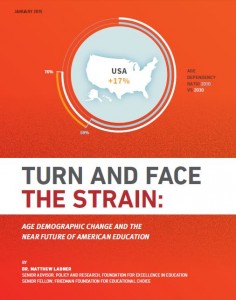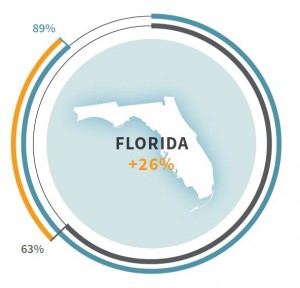 Demographic changes are expected to place a greater strain on government services over the next two decades, a new study says, and that should lend urgency to calls for states to overhaul their education systems.
Demographic changes are expected to place a greater strain on government services over the next two decades, a new study says, and that should lend urgency to calls for states to overhaul their education systems.
The report, “Turn and Face the Strain,” by Matthew Ladner, the Senior Advisor for Policy and Research with the Foundation for Excellence in Education and Senior Fellow with the Friedman Foundation for Educational Choice, warns about the problems associated with an increasing “age dependency ratio.” The report was co-released by the Foundation for Excellence in Education and the Friedman Foundation.
In short, the youth population is expected to continue growing, as is the elderly population. The number of adults aged 18-64 is not expected to keep up. As a result, by 2030, there will likely be more students and retirees depending on publicly funded education, pensions and medical care, without a proportional increase in the number of taxpayers to support those services.
“Broadly speaking, the age dependency ratio represents the number of people riding in the cart, compared to the number of people pushing the cart,” Ladner writes.
He has looked before at this issue and its implications for schools. The new report, released this morning, suggests the coming demographic squeeze he has predicted in Florida and elsewhere is likely to affect states all over the country. As a result, he argues, government programs, including education systems, will face increasing pressure to produce better results at a lower cost.
Between now and 2030, the United States will see 10,000 Baby Boomers retire each day. At the same time, the population of children in grades K-12 will continue to rise. Combined, these two growing populations increase the age dependency ratio.
Social Security, Medicare, Medicaid and education are some of the biggest expenses for state and federal governments, and the rapidly growing elderly and youth populations rely on them. Without raising taxes, cutting budgets, or implementing innovative cost-saving policies, one, or both, of these groups will lose out.
The U.S. Census Bureau estimates that the current age-dependency ratio in the United States is 59, meaning there are almost six retirees and students for every 10 working adults. By 2030, Ladner estimates that ratio will climb to 76.

All 50 states are expected to feel the strain, though some will get harder than others. Florida, already a mecca for retirees, will watch its age dependency ratio climb to a staggering 89, according to Ladner’s calculations, while the age dependency ratio in New Mexico and South Dakota is could exceed 90. The lowest ratio will be found in Washington at 69 beneficiaries per 100 taxpayers— six points higher than Florida’s current ratio.
The largest pinch comes from the growth in retirees. Overall, Baby Boomer retirement is estimated to explode the retiree population 78 percent by 2030. Meanwhile, the population of school age children is expected to grow a “meager” 16 percent by 2030 with 11 states seeing negative growth rates in the student population.
Rather than raising taxes on the relatively fewer working adults, or scaling back programs by cutting benefits, Ladner urges states to look for policies that achieve the same, or preferably better, results at a lower cost.
How does that apply to education?
Improving the quality of education has the potential benefit of producing more productive working adults and subsequently generate more tax revenue.
“Since the working-aged taxpayers of 2030 and beyond sit in American classrooms now,” Ladner, writes “substantial improvement in K-12 education results represents an incredibly urgent need.”
Some of the education reform proposals include ramping up school choice programs like charter schools, virtual schools, voucher and tuition tax credit programs as well as education savings accounts like the Personal Learning Scholarship Account in Florida.
Each of these education reform policies has lower operating costs than traditional schools and, in most cases, has produced similar or slightly better achievement gains for students. But some of these policies, like vouchers and charter schools, may not place enough emphasis on cost-control as Ladner might like.

As he has argued in other writings, for market forces to truly drive improvements in the education system, schools and other educational providers should have to compete not just on quality, but on price. He imagines a system of education savings accounts, in which parents can use unspent dollars for textbooks and school supplies or save them for future use.
Ladner concludes that the current levels of education spending growth are not sustainable. But rather than merely curbing spending or cutting budgets, he imagines a more decentralized education system, “with parents in control and making choices considering the full opportunity cost of spending will result in both improvement and efficiency.”
Read the full report for a state-by-state breakdown. You can read Matthew Ladner’s earlier work with redefinED on the age dependency ratio’s impact on Florida here, here and here.


